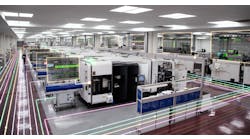On the machine shop floor, the influence of Artificial Intelligence (AI) is easy to recognize: quicker calculations, faster simulations, more intuitive programming, just to pick some simple examples.
And the Internet of Things (IoT) is a familiar presence too: that’s the invisible data network that allows your shop’s production systems to collect relevant data from external sources without prompting, and without pausing their primary task in managing manufacturing.
For the past decade or so, the major development in manufacturing technology has been what happens off the shop floor, outside the plant. It was the dynamic effects of information moving between machines, and how that data becomes enriched by these exchanges.
Now data experts say that the next step for manufacturing will be automating decision-making, ensuring that machines choose the best options offered by vast caches of information, in order to make manufacturing more efficient and productive.
Transforming machine shops into intelligent decision-making entities calls for a convergence of AI and IoT into the “Artificial Intelligence of Things” (AIoT.)
We asked cloud expert Roman Freidel, Global CoE Leader, Manufacturing, with Syntax, to explain the significance of this new phase.
Briefly, what is ‘Artificial Intelligence of Things’?
Roman Friedel: “In the past, decisions were made in the cloud. Sensors collected values and logged the data and sent it to the cloud. Then, the cloud processed that data and gained value from it, but that approach proved to be inefficient and expensive, especially in the event of an outage. But now, imagine having thousands of Internet of Things (IoT) endpoints that could perform multiple tasks simultaneously.
“What started as machine-to-machine (M2M) communication, limited almost exclusively to the manufacturing and telecom industries, is now everywhere. According to Statista, the number of devices connected to the internet will exceed 38 billion by 2025. In such a scenario, visual inspection, smart monitoring and other use cases in the manufacturing sector have brought us now to the middle of a fourth industrial revolution.
“Artificial Intelligence and IoT each provide a lot of advantages on their own, but bringing them together unlocks new opportunities and an immense amount of use cases. Smart factories and manufacturing companies deploying AIoT are frequently discovering new paths for innovation.
“I think as AIoT continues to develop, we will see the manufacturing industry continue to transform.
“IoT’s goal is to accumulate data and communicate it between things to benefit the user. AI helps computers make decisions as a human would, but when paired with IoT these connected devices can continue to learn on their own without human intervention.”
Did AIoT proceed from AI, or from IoT?
“I would argue that both have had their own respective paths and that manufacturers are just now realizing the full potential of AIoT in the smart factory. IoT started in consumer-facing goods like refrigerators or different wearables, but then made its way into the enterprise and even public spaces, such as waste management.
“AI has tracked a broad path as well, and has made an impact across industries from manufacturing and agriculture to marketing and advertising.”
When did it happen, and how?
“In my opinion, IoT and AI have been around for a long time, but computing back then was slow and expensive. With more computing power – and especially with cloud computing – having AI interact with Big Data harvested from IoT started to become more popular. AI became the brain and IoT, the nervous system.”
What are the “enhanced predictive capabilities” available thanks to AIoT?
“AIoT empowers an algorithm that applies predictive capabilities to give businesses a competitive edge. In other words, the data collected by sensors combine AI and IoT using AI techniques, such as machine learning and deep learning. These enhanced predictive scenarios could be trained in the cloud and executed on the edge level. This huge advantage quickly brings round-trip times (Request and Response) to the shop-floor level and enables the decision-making process of, e.g., changing parameters in real-time or deciding if a part is yield or scrap.
“In addition, your network bandwidth could be relieved as there is no permanent traffic. One example is from our German company, where we inspect every part with AI-supported in-line quality control. The use-case supports avoidance of typical defects – including cracks, necking, fractures of a car body part, etc. An image is captured from each part and then is visually inspected (up to 80 parts per minute.) The edge system can detect these defects automatically.”
What makes the shop floor “more connected” when applying AIoT?
“In the past, Manufacturing Execution Systems (MES) required data to execute their core functions properly. Most MES were mainly used for counts (yield/scrap), cycle times, and inventory updates, while Quality Management Systems (QMS) mainly required the rate and scrap reason code. With AIoT, the integration is much deeper.
“For example, they connect directly to existing sensors and can answer questions like: ‘What is the condition of the spindle? Does the cooling lubricant need to be refilled in a machine? Why is there a drop in pressure? What is the condition of the hydraulic pump motor? Is the temperature still within the target value?’
“This is achieved through IoT-ready cameras and Artificial Intelligence that knows what to look for based on previous patterns. For instance, in the automotive industry, this delivers the perfect level of accuracy and performance, whereas it would have been impossible for a human to maintain these levels of quality standards and production rates.”
What examples are available now to demonstrate these new shop-floor capabilities?
“One example is a global packaging manufacturer that produced sustainable and recyclable plastic films with a clear target of lowering their scrap rate even further. We were challenged to detect error patterns within their films, and there were multiple errors we focused on, including gauge band, layflat and telescoping.
“To reduce scrap rate, our solution was to sense minor thickness deviations, set up SPC (Statistical Process Control) and intervene directly in the process by adjusting the machines.
“We also pushed all data regarding power consumption to the cloud and leveraged AI to detect peak demand times and conduct other reporting procedures. This allowed us to detect anomalies and notify operators with real-time alerts, increasing our reaction time and efficiency.
“Also, we were able to view energy usage and transparency more in-depth, with real-time analytics.
“With real-time insights, AIoT was able to compare data from different days, and therefore, unlock savings in different areas. For example, it proposed different machine settings to enhance production and used forecasting capabilities to tell customers their future energy needs.
Roman Freidel is the Global CoE Leader, Manufacturing with Syntax, a cloud provider for implementing and managing multi-ERP deployments (SAP and Oracle) in a secure and resilient private, public, hybrid, or multi-cloud environment.






